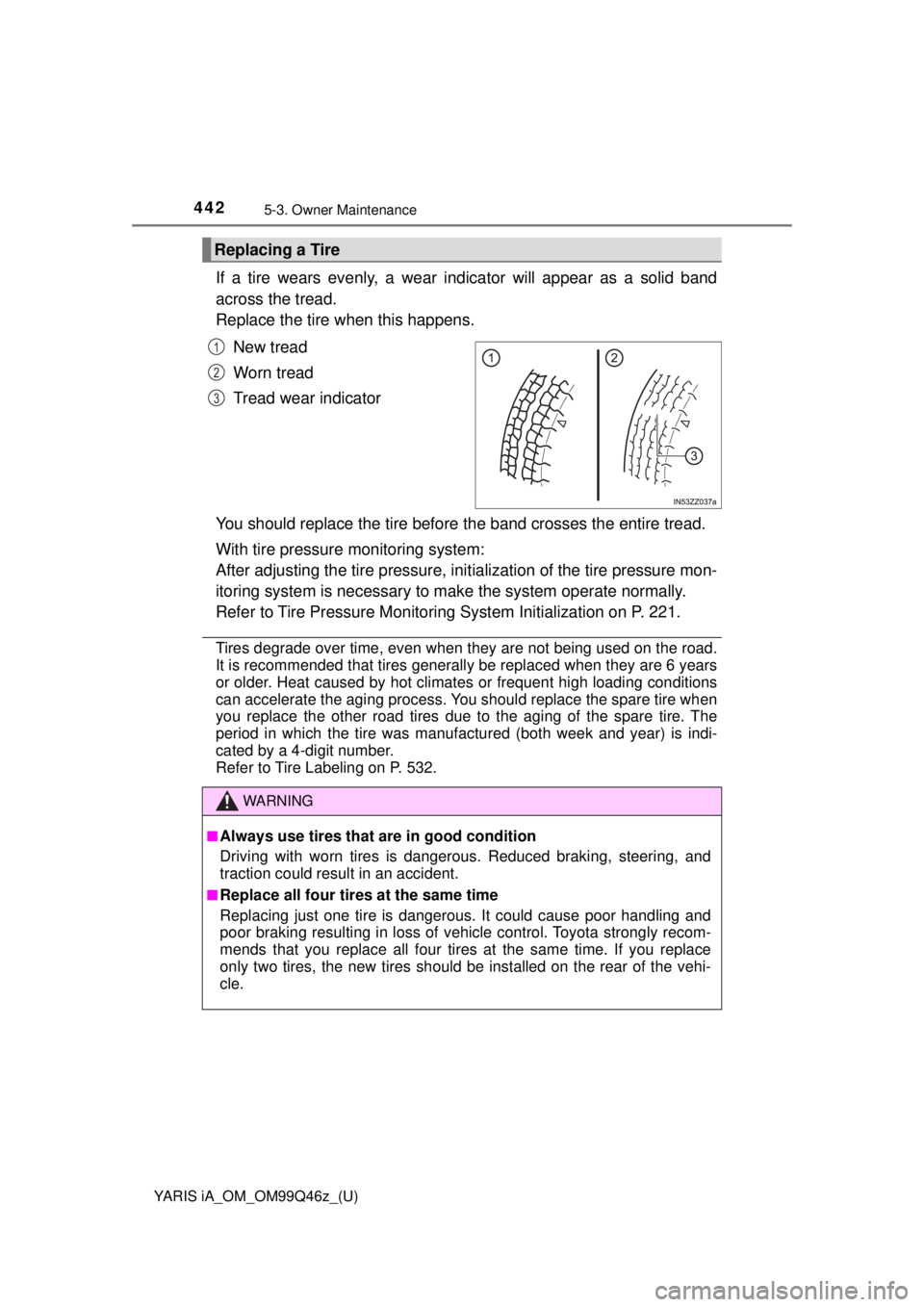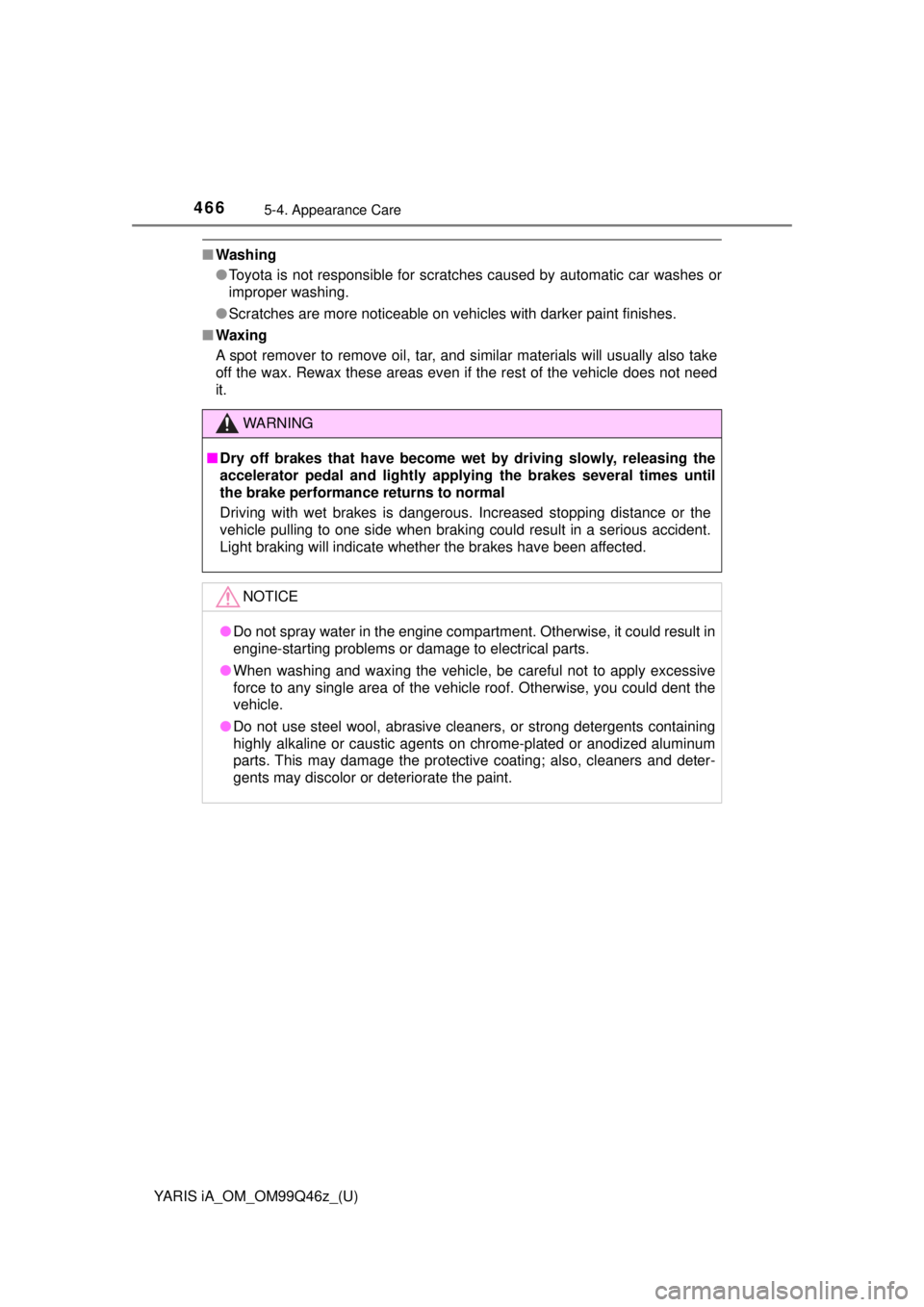Page 441 of 576

YARIS iA_OM_OM99Q46z_(U)
4415-3. Owner Maintenance
5
Maintenance and Care
Also, inspect them for uneven wear and damage. Abnormal wear is
usually caused by one or a combination of the following:• Incorrect tire pressure
• Improper wheel alignment
• Out-of-balance wheel
• Severe braking
After rotation, inflate all tire pressures to specification (
→P. 560) and
inspect the lug nu ts for tightness.
With tire pressure monitoring system:
After adjusting the tire pressure, init ialization of the tire pressure mon-
itoring system is necessary to make the system operate normally.
Refer to Tire Pressure Monitoring System Initialization on P. 221.
WARNING
■Rotate tires periodically
Irregular tire wear is dangerous. To equalize tire wear and extend tire
life, Toyota recommends that tire rotation is carried out at the same
interval as tire inspection.
For scheduled maintenance information, please refer to the “Owner’s
Manual Supplement/Scheduled Maintenance Guide”.
NOTICE
Rotate unidirectional tires and radial tires that have an asymmetrical
tread pattern or studs only from front to rear, not from side to side. Tire
performance will be reduced if rotated from side to side.
Page 442 of 576

4425-3. Owner Maintenance
YARIS iA_OM_OM99Q46z_(U)
If a tire wears evenly, a wear indicator will appear as a solid band
across the tread.
Replace the tire when this happens.New tread
Worn tread
Tread wear indicator
You should replace the tire before the band crosses the entire tread.
With tire pressure monitoring system:
After adjusting the tire pressure, init ialization of the tire pressure mon-
itoring system is necessary to make the system operate normally.
Refer to Tire Pressure Monitoring System Initialization on P. 221.
Tires degrade over time, even when they are not being used on the road.
It is recommended that tires generally be replaced when they are 6 years
or older. Heat caused by hot climates or frequent high loading conditions
can accelerate the aging process. You should replace the spare tire when
you replace the other road tires due to the aging of the spare tire. The
period in which the tire was manufactured (both week and year) is indi-
cated by a 4-digit number.
Refer to Tire Labeling on P. 532.
Replacing a Tire
1
2
3
WARNING
■Always use tires that are in good condition
Driving with worn tires is dangerous. Reduced braking, steering, and
traction could result in an accident.
■Replace all four tires at the same time
Replacing just one tire is dangerous. It could cause poor handling and
poor braking resulting in loss of vehi cle control. Toyota strongly recom-
mends that you replace all four tires at the same time. If you replace
only two tires, the new tires should be installed on the rear of the vehi-
cle.
Page 444 of 576
4445-3. Owner Maintenance
YARIS iA_OM_OM99Q46z_(U)
WARNING
■Always use wheels of the correct size on your vehicle
Using a wrong-sized wheel is dangerous. Braking and handling could
be affected, leading to loss of control and an accident.
NOTICE
A wrong-sized wheel may adversely affect:
●Tire fit
●Wheel and bearing life
●Ground clearance
●Snow-chain clearance
●Speedometer calibration
●Headlight aim
●Bumper height
●Tire Pressure Monitoring System (if equipped)
Page 446 of 576
4465-3. Owner Maintenance
YARIS iA_OM_OM99Q46z_(U)
WARNING
■Never touch the glass portion of a ha logen bulb with your bare hands
and always wear eye protection when handling or working around the
bulbs
When a halogen bulb breaks, it is dangerous. These bulbs contain pressur-
ized gas. If one is broken, it will explode and serious injuries could be
caused by the flying glass.
If the glass portion is touched with bare hands, body oil could cause the
bulb to overheat and explode when lit.
■ Always keep halogen bulbs out of the reach of children
Playing with a halogen bulb is dangerous. Serious injuries could be caused
by dropping a halogen bulb or breaking it some other way.
NOTICE
When removing the lens or lamp unit using a flathead screwdriver, make
sure that the flathead screwdriver does not contact the interior terminal. If
the flathead screwdriver contacts the terminal, a short circuit may occur.
Page 457 of 576
YARIS iA_OM_OM99Q46z_(U)
4575-3. Owner Maintenance
5
Maintenance and Care
If any fuse but the MAIN fuse
is blown, replace it with a
new one of the same amper-
age rating.Normal
Blown
Reinstall the cover and make sure that it is securely installed.3
1
2
WARNING
■Do not replace the main fuse and multiplex slow blow fuse by yourself.
Have your Toyota dealer perform the replacement
Replacing these fuses by yourself is dangerous because they are high cur-
rent fuses. Incorrect replacement could cause an electrical shock or a short
circuit resulting in a fire.
NOTICE
Always replace a fuse with a genuine Toyota fuse or equivalent of the same
rating. Otherwise you may damage the electric system.
4
Page 459 of 576
YARIS iA_OM_OM99Q46z_(U)
4595-3. Owner Maintenance
5
Maintenance and Care
15A/C MAG7.5 AAir conditioner
16AT P U M P15 A—
17AT15 ATransaxle control system (if equipped)
18D.LOCK25 APower door locks
19H/L RH20 AHeadlight (RH)
20ENG+B27.5 AEngine control system
21TA I L20 ATaillights, License plate lights, Parking
lights
22———
23ROOM25 AOverhead light
24FOG15 AFog lights (if equipped)
25H/CLEAN20 A—
26STOP10 ABrake lights
27HORN15 AHorn
28H/L LH20 AHeadlight (LH)
29ABS/DSC S30 AABS, Dynamic stability control system
30HAZARD15 AHazard warning flashers, Turn signal lights
31FUEL PUMP15 AFuel system
32FUEL WARM25 A—
33WIPER20 AFront window wiper and washer
34CABIN+B50 AFor protection of various circuits
35FA N 230 ACooling fan
36FUEL PUMP30 A—
37ABS/DSC M50 AABS, Dynamic stability control system
38EVVT20 A—
39———
40FA N 130 ACooling fan
41FA N 340 A—
42ENG.MAIN40 AEngine control system
DESCRIPTIONFUSE
RATINGPROTECTED COMPONENT
Page 463 of 576

YARIS iA_OM_OM99Q46z_(U)
4635-4. Appearance Care
5
Maintenance and Care
●Prevention
It is necessary to have your Toyota washed and waxed to pre-
serve its finish according to the in structions in this section. This
should be done as soon as possible.
Bird droppings can be removed with a soft sponge and water. If
you are traveling and these are not available, a moistened tissue
may also take care of the problem. The cleaned area should be
waxed according to the inst ructions in this section.
Insects and tree sap are best removed with a soft sponge and
water or a commercially available chemical cleaner.
Another method is to cover the affected area with dampened
newspaper for one to two hours. After removing the newspaper,
rinse off the loosened debris with water.
■Water Marks
● Occurrence
Rain, fog, dew, and even tap water can contain harmful minerals
such as salt and lime. If mois ture containing these minerals set-
tles on the vehicle and evapor ates, the minerals will concentrate
and harden to form white rings. The rings can damage your vehi-
cle’s finish.
● Prevention
It is necessary to wash and wax your vehicle to preserve its finish
according to the instructions in this section. These steps should
be taken immediately after you find water marks on your vehi-
cle’s finish.
■Paint Chipping
● Occurrence
Paint chipping occurs when gravel thrown in the air by another
vehicle’s tires hits your vehicle.
● How to avoid paint chipping
Keeping a safe distance between you and the vehicle ahead
reduces the chances of having your paint chipped by flying
gravel.
Follow all label and container directions when using a chemical
cleaner or polish. Read all warnings and cautions.
Page 466 of 576

4665-4. Appearance Care
YARIS iA_OM_OM99Q46z_(U)
■Washing
●Toyota is not responsible for scratches caused by automatic car washes or
improper washing.
● Scratches are more noticeable on vehicles with darker paint finishes.
■ Waxing
A spot remover to remove oil, tar, and similar materials will usually also take
off the wax. Rewax these areas even if the rest of the vehicle does not need
it.
WARNING
■Dry off brakes that have become wet by driving slowly, releasing the
accelerator pedal and lightly applyi ng the brakes several times until
the brake performance returns to normal
Driving with wet brakes is dangerous. Increased stopping distance or the
vehicle pulling to one side when braking could result in a serious accident.
Light braking will indicate whether the brakes have been affected.
NOTICE
● Do not spray water in the engine compartment. Otherwise, it could result in
engine-starting problems or damage to electrical parts.
● When washing and waxing the vehicle, be careful not to apply excessive
force to any single area of the vehicle roof. Otherwise, you could dent the
vehicle.
● Do not use steel wool, abrasive cleaners, or strong detergents containing
highly alkaline or caustic agents on chrome-plated or anodized aluminum
parts. This may damage the protective coating; also, cleaners and deter-
gents may discolor or deteriorate the paint.